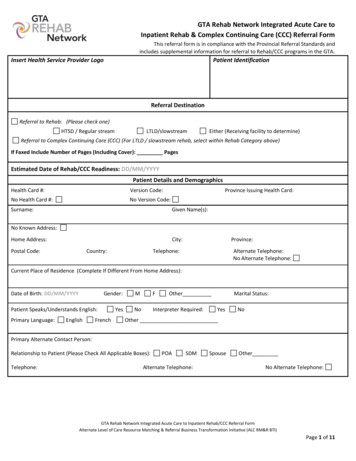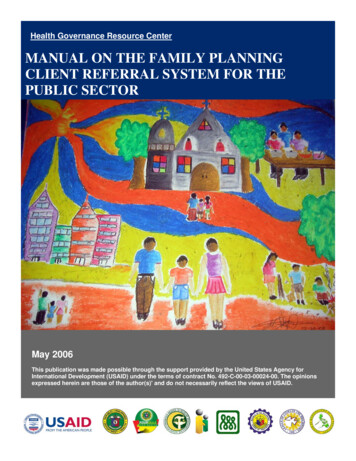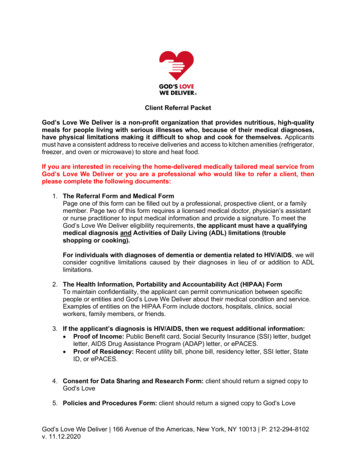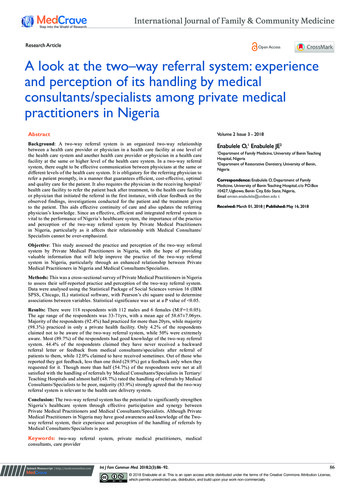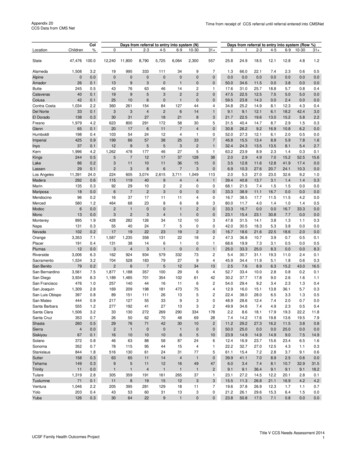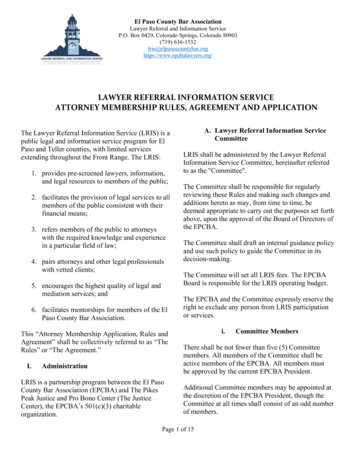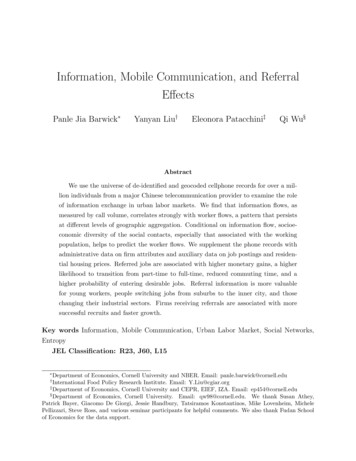
Transcription
Information, Mobile Communication, and ReferralEffectsPanle Jia Barwick Yanyan Liu†Eleonora Patacchini‡Qi Wu§AbstractWe use the universe of de-identified and geocoded cellphone records for over a million individuals from a major Chinese telecommunication provider to examine the roleof information exchange in urban labor markets. We find that information flows, asmeasured by call volume, correlates strongly with worker flows, a pattern that persistsat different levels of geographic aggregation. Conditional on information flow, socioeconomic diversity of the social contacts, especially that associated with the workingpopulation, helps to predict the worker flows. We supplement the phone records withadministrative data on firm attributes and auxiliary data on job postings and residential housing prices. Referred jobs are associated with higher monetary gains, a higherlikelihood to transition from part-time to full-time, reduced commuting time, and ahigher probability of entering desirable jobs. Referral information is more valuablefor young workers, people switching jobs from suburbs to the inner city, and thosechanging their industrial sectors. Firms receiving referrals are associated with moresuccessful recruits and faster growth.Key words Information, Mobile Communication, Urban Labor Market, Social Networks,EntropyJEL Classification: R23, J60, L15 Department of Economics, Cornell University and NBER. Email: panle.barwick@cornell.eduInternational Food Policy Research Institute. Email: Y.Liu@cgiar.org‡Department of Economics, Cornell University and CEPR, EIEF, IZA. Email: ep454@cornell.edu§Department of Economics, Cornell University. Email: qw98@cornell.edu. We thank Susan Athey,Patrick Bayer, Giacomo De Giorgi, Jessie Handbury, Tatsiramos Konstantinos, Mike Lovenheim, MichelePellizzari, Steve Ross, and various seminar participants for helpful comments. We also thank Fudan Schoolof Economics for the data support.†
1IntroductionInformation affects every aspect of economic decisions, from firm production to householdconsumption, from government regulation to international treaty negotiations. Classicalanalysis assumes that agents choose actions to maximize payoff under perfect information(Arrow and Debreu, 1954). In reality, information is rarely perfect. Agents’ informationsets differ substantially, as highlighted by the influential literature on information asymmetry (Akerlof, 1970; Spence, 1973; Rothschild and Stiglitz, 1976). In addition, informationexchange and acquisition are costly and crucially depend on social interactions among individuals.Quantifying the effect of information exchange among social entities and individuals oneconomic outcomes is challenging because it is difficult to measure the extent of informationexchange, and even more so the quality of information that is passed on from one agent toanother. The widespread use of location-aware and Global Positioning System (GPS) technologies in mobile phone devices provides a novel avenue that helps researchers to quantifythe extent of information flow among individuals, while also tracking their movements inphysical space. Datasets derived from these geocoded phone communication records presentthree unique advantages over traditional ones. First, the frequency and intensity of callingrecords provide a direct measure of information exchange. Second, the panel data natureof these datasets make it feasible to follow individuals over time and space and controlfor individual unobserved attributes. Third, such data portray a more accurate profile ofindividuals’ social networks than do surveys commonly used in the literature. Existing research has documented that mobile phone usage predicts human mobility (Gonzalez et al.,2008), migration (Blumenstock et al., 2019), poverty and wealth (Blumenstock et al., 2015),credit repayment (Bjorkegren and Grissen, 2018), restaurant choices (Athey et al., 2018),and residential location choices (Buchel et al., 2019).In this paper, we analyze the impact of information exchange on labor market dynamics.Our empirical research has the following goals. First, we investigate the extent to whichinformation flow is accompanied by worker flows. Second, we examine how information flowamong social contacts affects job transitions and the efficiency of worker-vacancy matches.To this end, we exploit the universe of de-identified and geocoded cellphone records froma major Chinese telecommunication service provider over the course of twelve months in anorthern Chinese city. These detailed records enable us to construct measures of informationflow between geographic areas and among individuals, as well as variables on employmentstatus, history of work locations, home locations, and demographic attributes. We supplement our phone records with administrative data on firm attributes (industry classification1
and payroll) and auxiliary data sets on residential housing prices and job postings for additional socioeconomic measures.Our analysis begins with documenting that information flow as measured by the frequency of phone calls correlates strongly with worker flows. Such a correlation persists atdifferent levels of spatial aggregation. Conditional on the number of phone calls exchanged,the diversity of individuals’ social contacts (sources of information) also matters. Withindifferent diversity measures, diversity in socioeconomic status is more valuable than diversityin spatial locations. As far as job mobility is concerned, diversity in the information sourcespossessed by the working population is far more critical than that by the residential population. Surprisingly, in terms of the relationship between information diversity and economicdevelopment, our data exhibit remarkable similarity to the UK data analyzed by Eagle et al.(2010), highlighting the potentially wide applicability of this finding in different settings.Having illustrated the importance of information flow with respect to worker flow, weexamine the role of job-related information shared by social contacts (or friends) on jobswitches.1 When an individual moves to a pre-existing friend’s workplace, we define such afriend as ‘a referral’. We first document via event studies that the intensity of informationflow between workers and their referrals exhibits an inverted-U shape that peaks at thetime of the job switch. In contrast, the information flow between workers and non-referralfriends remains stable throughout the sample period, with no noticeable differences duringthe months that precede job switches. Such distinctions in calling patterns are not drivenby changes in the number of social contacts, which is steady throughout our sample period.We define the referral effect as the effect of having social contacts in a given workplaceon individuals’ work location choices. We quantify the referral effect using the differencein a job seeker’s propensity to switch to a friend’s workplace versus a work location in thesame neighborhood but without a friend. One might be concerned that our definition ofthe referral effect suffers from confounding factors. For example, firms sometimes relocate,consolidate, or open new plants in different areas. If employer relocate employees in differenttime periods, we might observe workers moving to the neighborhood of pre-existing socialcontacts. This is unlikely to be important in our study since multi-plant firms are rare in ourdata set. To the extent that it matters, we tackle it by adding the interaction of the origin anddestination neighborhood fixed effects. In other words, we compare individuals who share thesame origin-destination neighborhood pair but have different social networks and examinetheir choices of workplace locations with and without friends. These origin-destinationneighborhood interactions also control for geospatial attributes that are correlated with jobflows (commercial centers, industrial clusters, etc.)1We use social contacts and friends interchangeably in this paper.2
A long-standing challenge in the referral literature that examines observational data is thedifficulty in distinguishing a referral effect from homophily and sorting. If individuals sharesimilar skills and preferences with their friends, then an individual might move to a locationwhere a friend works, not because of the referral information but because the vacant positionrequests certain skill sets. In addition, not all locations have desirable openings. Leveragingthe richness and structure of our data, we conduct three falsification tests. First, we limitour analysis to individuals for whom there is at least one additional location within the sameneighborhood that has vacancy listings in the same occupation and salary range as the onethat the job switcher takes. This mitigates the concern that individuals sort into friends’locations as a result of the availability of job opportunities, rather than useful informationprovided by referrals. Second, we distinguish between friends who are currently working inthe location (referrals) and friends who used to work there but moved away prior to the jobswitch. Given that sorting into friends’ locations by unobserved preferences or skills shouldhappen regardless of a friend’s current location, we would expect to find similar estimatesfor both types of friends if our estimated referral effects primarily reflect sorting. Third,we compare friends who work in the location (referrals) with friends who live but not workat the location where a job switcher moves to. Larger estimates for friends working in thelocation would be consistent with referrals: affiliation with the workplace enables referralsan information advantage of job openings over other types of friends. Our results from thesedifferent tests illustrate that referrals are indeed much more important than friends whomoved away prior to the job switch and friends who live but not work there, indicating thatour estimated referral effects are unlikely to be driven by sorting.In addition to these falsification tests, we have conducted an extensive set of robustnessanalyses to examine homophily. In the first set of regressions, we directly control for theextent of similarity (and hence homophily) in switchers’ and referrals’ observable attributes,i.e. whether they share the same age and gender, are born in the same county, and livein houses with a similar property value. As ‘birds of a feather flock together’, we alsoexamine attributes of their social contacts. Besides these direct controls, we have adopted apopular unsupervised machine learning algorithm, the k-means clustering algorithm, to nonparametrically profile switchers and referral friends based on their own attributes as wellas the attributes of their social contacts. Switchers and referral friends in the same clusterare more similar than if they belong to different clusters. The estimated referral effect isquite stable across these different specifications, indicating that our results are not driven byhomophily and that the baseline controls are adequate at controlling for differences acrossindividuals.Another potential explanation for the referral effect is preference: individuals might prefer3
to work with friends, as shown in Park (2019). By exploiting the spatial variation of thenumber of social contacts, we show that while switchers prefer work locations where they canmingle with friends, this preference is modest. Having more than one friend in a locationleads to a small increase in the probability of switching to that location, everything elsethe same. Similarly, having more friends in the new work location relative to the old worklocation only slightly increases the job switching probability. In both cases, our estimatedreferral effect is robust to controlling individuals’ preference to work with friends.In addition to homophily and preference, we have examined several other alternative explanations, including unobserved location attributes and local labor market demand, reversecausality, as well as the spatial distribution of friends. We have also tested alternative frienddefinitions and limited the sample to locations that are likely occupied by one large firm.The referral effect survives these additional robustness analyses.In terms of effect heterogeneity, referrals are particularly important for young workers,people switching jobs from suburbs to the inner city, and those who change sectors. Theseresults are in line with the observation that information asymmetries are more severe inthese settings and hence referrals are more valuable. We also provide evidence that strongsocial ties are associated with a larger referral effect, corroborating results in the literatureon weak ties vs. strong ties.According to our definition, at least one in every four jobs are based on referrals. Havinga referral in a location increases by close to four times the likelihood that an individual movesthere – a pattern that is consistent with previous studies carried out in various countries(Ioannides and Loury, 2004). We compare our referral definition with two commonly usedmeasures of referrals in the literature, namely residential neighbors (Bayer et al. 2008) andindividuals belonging to the same ethnic group or immigrant community (Edin et al. 2003),the latter of which is analogous to individuals born in the same county in our setting.As expected, residential neighbors and people born in the same county are more likely tocommunicate with each other, thus validating these two measures. Nonetheless, while thereferral effect from these two alternative referral definitions is positive and significant, it ismuch lower than our baseline estimate. As a result, the reported estimate in the literaturethat is derived from these referral proxies is likely to be a lower bound of the true referraleffect.Job information passed on via referrals is valuable for workers. Specifically, referral jobsare associated with higher wages and non-wage benefits, shorter commutes, and a greaterlikelihood to transition from part-time to full-time and from regular jobs to premium ones.Information transmitted through the referral networks is also valuable for firms. We findsuggestive evidence that firms whose employees have a larger social network are more likely to4
have successful recruits, achieve higher retention rates, and experience faster growth. Finally,referrals improve labor market efficiency by providing better matches between workers andvacancies, and mitigate labor market inequality, as women and migrants are more likely tofind jobs through referrals.Finally, we replicate our analysis on individuals who are laid off and then successfullyfind a job during our sample period. This contrasts the bulk of our analysis described abovethat examines individuals who switch from one job to another with minimal job disruption.Nonetheless, the event studies reveal a remarkably similar pattern in terms of the informationflow intensity between the unemployed individuals and their referrals. The number of phonecalls between these referral pairs also exhibits an inverted-U shape that peaks at the timeof reemployment. In addition, the estimated referral effect varies from 0.31 to 0.33, veryclose to the baseline estimate derived from individuals without an employment gap. Whilethe short time-span of our sample creates selection issues – the analysis is constrained toindividuals who successfully find a job within a short time window post their layoff – andprevents us from a rigorous analysis on the nature of job search during unemployment, thesefindings provide suggestive evidence that the communication patterns we document and thereferral effect we estimate are potentially applicable to all job seekers, whether employed orunemployed.We end with an important caveat. Our analysis is based on mobile phone communicationsbecause we do not have micro-level data on communication and information exchange viaother channels, such as text messages, mobile apps (such as WeChat), and web-based media(such as emails). Nonetheless, we present evidence that different information channels arecomplements: people who frequently communicate via phone conversations are also morelikely to use other channels, such as text messages and Wechat, and more likely to browseinternet. In addition, the positive correlation exists both across individuals and withinindividuals and over time.Our work contributes to the emerging literature that demonstrates how the widespreaduse of electronic technologies, and, consequently the wealth of information on individual digital footprints, opens new frontiers for urban economics (Bailey et al., 2018b; Glaeser et al.,2015; Donaldson and Storeygard, 2016). A pioneering study by Henderson et al. (2012)exploits satellite data to conduct an analysis on urban economic activities at a finer levelof spatial disaggregation than traditional studies. Using predicted travel time from GoogleMaps, Akbar et al. (2018) construct city-level vehicular mobility indices for 154 Indian citiesand propose new methodologies to improve our understanding of urban development. Otherstudies examine housing decisions (Bailey et al., 2018a), households’ responses to incomeshocks (Baker, 2018), and entrepreneurship and investment (Jeffers, 2018). Our work con5
tributes to this literature by combining mobile phone records with traditional socioeconomicdata to shed light on urban labor market mobility at fine geographical and temporal scales.Another relevant strand of literature examines the role of social networks in job searches(Topa, 2011; Schmutte, 2016). To identify referred workers, this literature uses surveys orassumes interactions and exchange of job information between social ties, such as formerfellow workers (Cingano and Rosolia 2012; Giltz 2017; Saygin et al. 2018), family ties (Kramarz and Skans 2014), individuals who belong to the same immigrant community or ethnicgroup (Edin et al. 2003; Munshi and Rosenzweig 2013; Beaman 2012; Dustmann et al. 2016;Aslund et al. 2014), residential neighbors (Bayer et al. 2008; Hellerstein et al. 2011; Hellerstein et al. 2014; Schmutte 2015), and Facebook friends (Gee et al. 2017a). The paper closestto ours is Bayer et al. (2008), who also study the importance of referral effects in an urbanmarket. Using Census data on residential and employment locations, they document thatindividuals who reside in the same city block are more likely to work together than those wholive in nearby blocks, and they interpret these findings as evidence of social interactions. Wecontribute to this literature by providing a more refined measure of social networks and information exchange among individuals, and we introduce complementary data on vacanciesand firm attributes to cover a diverse set of economic outcomes.Our study is also related to the literature on weak vs. strong ties. The seminal study byGranovetter (1973) argues that weak ties could be more important because of their accessto a diverse set of information. This study has spurred a large literature on whether weakties are more effective for information transmission. Aral and Alstyne (2011) shows thatthe importance of weak ties and strong ties could be context dependent. Kramarz andSkans (2014) find that strong social ties are an important determinant for where youngworkers find their first job. Using facebook users from fifty countries, Gee et al. (2017b)document that strong ties are more important than weak ties in job finding at the margin,though collectively weak ties are more important because they are numerous. Our resultscorroborate the findings in the existing literature that the (marginal) referral effect is morepronounced among strong social ties.Fourth, our work is related to the empirical literature on information economics. Recentstudies have shown that increasing information transparency (for example, through betterlabels and postings) helps consumers’ perceptions of product attributes (e.g., Smith andJohnson 1988), improves consumer choices (e.g., Hastings and Weinstein 2008; Barahonaet al. 2021), and drives up average product quality (e.g., Jin and Leslie 2003; Bai 2018). Ouranalysis contributes to this strand of literature by quantifying the importance of informationexchange through referrals in facilitating urban labor market mobility. Last but not least,our study is also related to the literature on diversity, including Page (2007) and Eagle et al.6
(2010). We propose novel measures for the diversity of socioeconomic outcomes and illustratethe important role they play in shaping worker flows.The paper proceeds as follows. Section 2 discusses data, the institutional background,and descriptive evidence. Section 3 presents event studies and baseline regressions on thereferral effects. Section 4 reports an extensive set of robustness analyses and rules outalternative explanations. Section 5 analyzes the referral benefits to both workers and firms.Section 6 replicates the analysis to workers with employment gaps. Section 7 concludes.2Data and Descriptive Evidence2.1DataWe have compiled a large number of data sets for our analysis. Besides data on geocodedphone records, we have assembled administrative data on firm attributes and auxiliary dataon neighborhood attributes, residential housing prices, and vacancies (job postings).Geographical Units At the highest level, the city we study is divided into twenty-threeadministrative districts and counties.2 These districts and counties are further broken into1,406 neighborhoods that are delineated by major roads. A neighborhood is similar tobut smaller in size than a census block in the U.S. There are 917 neighborhoods in theurban center of the city and 489 neighborhoods in surrounding suburbs (see Figure 1 for asection of the city map).3 The lowest level of a geographical unit is a location, a geographicposition returned by a cellular tower station, which represents a building complex or anestablishment within a neighborhood. The median and average number of distinct locationsin a neighborhood is seven and thirteen, respectively. In total there are close to eighteenthousand locations.Spatial attributes come from two GIS shape files (maps). The first shape file delineatesadministrative divisions, roads, highways, railways, parks, as well as points of interests,such as hospitals, schools, shopping mall, parking lots, and restaurants. The second shapefile depicts neighborhood boundaries. We overlay these shape files to obtain the spatialattributes for each location and neighborhood.2The city consists of an urban core which is divided into eight districts, and fifteen surrounding suburbanand rural counties. These eight districts and fifteen counties are all equal parts of the city proper and underits administrative authority.3These neighborhoods are constructed by our data provider for billing purposes. The average size for anadministrative district/county, a neighborhood in the urban core, and a neighborhood in the suburb is 712km2 , 0.45 km2 , and 25.03 km2 , respectively.7
Call Data China’s cellphone penetration rate is very high. According to the China FamilyPanel Studies (CFPS), a nationally representative longitudinal survey of individuals’ socialand economic status since 2010, 85% of correspondents sixteen years and older report possessing a cellphone.Our anonymized and geocoded call data contain the universe of phone records for allmobile phone subscribers of a major Chinese telecommunications company in a city thatcover the period of November 2016 to October 2017. The data provider (hereafter CompanyA) serves between 30-65% of all mobile phone users in the city we study.4Cellphone usage records are automatically collected when individuals send a text message,make a call, use apps, or browse the internet. These records include individual identifiers(IDs), location at the time of usage, and the time and duration of usage. The data we haveaccess to are aggregated to the weekly level and contain encrypted IDs of the calling partyand the receiving party, call frequency and duration in seconds, whether or not a user isCompany A’s subscriber, and the demographic information about the subscribers, such asage, gender, and place of birth. The birth county enables us to distinguish migrants fromlocal residents. The existing literature has shown that migrants are much more likely to referand work with other migrants from their birth city and province (Dai et al., 2018).An important advantage of our data is the geocoded locations whenever the mobile deviceis used and every 15 minutes when the device is turned on. The serving cellular tower stationrecords a geographic position in longitude and latitude that is accurate up to a 100-200 meterradius, or roughly the size of a large building complex. For each individual and week, weobserve the location that has the most frequent phone usage (calls, texts, apps, internetbrowsing, etc.) between 9am and 6pm during the weekdays (which we call a ‘work location’)as well as the location that has the most frequent usage between 10pm and 7am for the sameweek (which we call a ‘residential location’).5 In contrast to traditional data sets in socialscience studies that lack fine-grained geographical information about human interactions,these geocoded locations trace out individuals’ spatial trajectories over time and allow us toconstruct a diverse set of social ties (including friends, neighbors, past and present coworkers,friends’ coworkers, etc.).Constructing individuals’ workplace history using recorded geocodes is the most crucial4There are three major telecommunications companies in China. We report a range for the marketshare to keep company A anonymous. For individuals with multiple phones, we observe usage on the mostcommonly used phone. If they subscribe to services from multiple carriers (which is uncommon), we onlyobserve activities within company A. China adopted the ‘real-name system’ in 2011; since January 2017,mobile phones that do not pass the real-name authentication cannot operate in China. This allows us toidentify individuals based on their anonymized IDs.5Phone usage during 7am-9am and 6pm-10pm is excluded because people are likely on the move duringthese time intervals.8
step of our analysis. Since we do not directly observe the employment status or place ofwork, we take a very conservative approach in order to mitigate measurement errors inwork-related variables. There are 1.6 million individuals in the raw data. We focus on thosewith valid work locations for at least forty-five weeks – a period long enough to preciselyidentify workplaces. Locations that are visited during the working hours on a daily basisfor weeks in a row are likely to be a workplace rather than shopping centers or recreationalfacilities. This gives us 560k individuals.6 After further restricting to individuals who haveat most two working locations throughout the sample period (which excludes sales personsand individuals with out-of-town business travels and family visits) and for whom we havethe complete demographic information, our final sample reduces to 456k users. We carryout the core empirical analysis using this sample and conduct robustness checks in Section4 using less stringent sample selection criteria.Job switchers We identify individual i as a job switcher if the following criteria aresatisfied. First, as shown in Figure 2, a job switcher is someone who worked in two worklocations, is observed at least four weeks in either location, and switches locations only once.Second, the distance between these two locations must be at least 1 km. We choose thecutoff of 1 km to avoid erroneously identifying someone as a switcher, because individuals’work locations are geocoded up to a radius of 100-200 meters (the average distance betweenneighborhood centroids is 1.4km). Among the 456k users in our final sample, 8% (38,102) areidentified as job switchers. Though constructed using different data sources, this on-the-jobswitching rate is similar to that reported in the literature for China’s labor market, whichis around 7% (Nie and Sousa-Poza, 2017). China’s job-to-job mobility is lower than thatin Western countries (e.g., 15-18% in the European Union as documented in Recchi 2009),partly because of the Hukou system which imposes significant restrictions on individuals’migration across provinces or from rural to urban areas (Ngai et al., 2017; Whalley andZhang, 2007). Our switchers found jobs in a total of 5,800 unique work locations that arespread out in 1,100 neighborhoods. Two-thirds of these locations are in the urban core; thereminder are in surrounding counties.Vacancy Data To gauge the dynamics of local labor market conditions, we collect listingsfrom the two largest online job posting websites, zhilian.com and 58.com, from August 20166Several factors contribute to the sample attrition. China’s cellphone market is dynamic with a highfraction of subscribers switching carriers during each month, especially among people on prepaid plans. Inaddition, the work location information is missing for weeks when individuals travel out-of-town or experiencefrequent location changes (common for unemployed or part-time workers, salesman, etc.).9
to February 2018.7 These websites hold on average 10,000 job postings per month. Weobtained a total of 121,055 postings and merge them to our call data based on locations.Each posting reports the posting date, job title and description, full time or part time,qualifications (the minimum education level and years of experience), monthly salary (in arange), firm address, firm size (the number of total employees), and firm industry. On thebasis of the job title and description, we group these postings into eight occupations usingthe 2010 U.S. occupation code. Popular occupations include Professionals (26.70%), Service(26.61%), Sal
popular unsupervised machine learning algorithm, the k-means clustering algorithm, to non-parametrically pro le switchers and referral friends based on their own attributes as well as the attributes of their social contacts. Switchers and referral friends in the same cluster are more similar than if they belong to di erent clusters.
